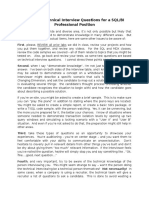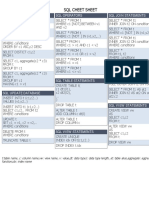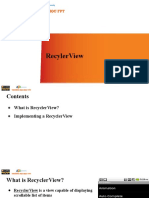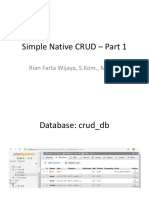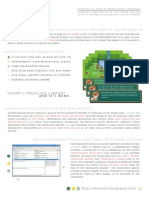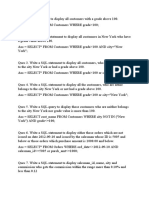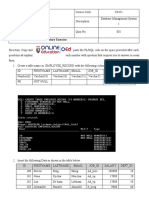Deloitte data analyst interview experience (0-3 yr)(sql,powerbi)
SQL: 5 questions
Q1: Explain the difference between RANK(), DENSE_RANK(), and
ROW_NUMBER() functions using example. Q2 – Q4 use Table: employee
(EmpID, ManagerID, JoinDate, Dept, Salary)
Q2: Find the nth highest salary from the Employee table.
Q3: You have an employee table with employee ID and manager ID. Find all
employees under a specific manager, including their subordinates at any level.
Q4: Write a query to find the cumulative salary of employees department-wise,
who have joined company in last 30 days.
Q5: Find the top 2 customers with the highest order amount for each product
category, handling ties appropriately. Table: customer (CustomerID,
ProductCategory, OrderAmount)
Power BI: 3 questions
Q1: Explain step-by-step how will you create a sales dashboard from scratch.
Q2: Explain how you can optimize a slow Power BI report.
Q3: Explain Any 5 Chart Types and Their Uses in Representing Different
Aspects of Data.
Behavioral: 2 Questions
Q1: Why you want to become a data analyst and why did you apply to this
company?
Q2: Describe a time when you had to manage a difficult task with tight
deadlines. How did you handle it?
1
� Goldman Sachs Data Analyst Interview Experience (2+ years)
SQL:
1. Calculate the average salary for each department from the table.
2. Write a SQL query to display the employee’s name along with their manager’s
name using a self-join on the ‘employees’ table, which contains ‘emp_id’, ‘name’,
and ‘manager_id’ columns.
3. Find the most recent hire for each department (solved using LEAD/LAG
functions).
4. Write a query to retrieve the nth highest salary from the Employees table, which
has ‘EmployeeID’, ‘Name’, and ‘Salary’ columns.
Power BI:
1. What is meant by Filter context in DAX?
2. Explain the process of implementing Row-Level Security (RLS) in Power BI.
3. Describe the different types of filters available in Power BI.
4. What’s the difference between the ‘ALL’ and ‘ALLSELECTED’ functions in
DAX?
5. How would you use DAX to calculate total sales for a specific product?
Python:
1. Create a dictionary, add elements, update a specific entry, and print the
dictionary sorted by key in alphabetical order.
2. Identify unique values from a list of numbers and print how many times each
value occurs.
3. Find and print the duplicate values in a list of numbers, along with their frequency. In
addition to the technical questions, one of the rounds focused primarily on my previous
work experience and included a case study discussion
2
� EY data analyst interview experience (2 year experience)
1. Tell me about yourself & your roles-responsibilities at your current work place.
2. how much you would rate yourself in SQL
3. 3. How to find the values in a text column of a table that start with a certain letter
4. What is a Recursive Stored Procedure?
5. Find the candidates best suited for an open Data Science job. You want to find
candidates who are proficient in Python, Tableau, and PostgreSQL.(table has two
colunms (name ,skills)).
6. He asked about tableau related secnario based questions .
a. what is tableau prep and how will you get it
b.what is tableau server .
3
� KPMG Data Analyst Interview Experience (2+ years)
SQL:
1. Write a query to calculate the total revenue generated by each region.
2. Display the names of employees who have a salary above the average salary in their
department.
3. Identify the second highest salary in each department from the ‘employees’ table,
which has ‘emp_id’, ‘department_id’, and ‘salary’ columns.
4. Write a SQL query to find employees who have not had any recent sales in the last 3
months.
Power BI:
1. Explain how you would create a dynamic date filter in Power BI for last month’s data.
2. Describe the steps for setting up role-based access in Power BI using Row-Level
Security (RLS).
3. What is the difference between a calculated column and a measure in Power BI?
4. How would you approach building a KPI dashboard that tracks multiple metrics over
time?
Python:
1. Write a Python function to filter out customers who have made more than 5 purchases
in the last 6 months.
2. Create a program that reads a CSV file, extracts unique values in a column, and saves
the results in a new file.
3. Develop a Python script to visualize monthly sales trends for a dataset using Matplotlib
or Seaborn.
Case Study Round (Guesstimate Focus): In addition to technical questions, there was a
guesstimate question to test analytical thinking.
— Estimate the number of coffee cups sold in New York City daily.
4
� Meesho Data Analyst Interview Experience (Freshers)
Power BI Questions:
1. Explain the concept of context transition in DAX and provide an example.
2. How would you optimize a complex Power BI report for faster performance?
3. Describe the process of creating and using calculation groups in Power BI.
4. Explain how you would handle large datasets in Power BI without compromising
performance.
5. What is a composite model in Power BI, and how can it be used effectively?
6. How does the USERELATIONSHIP function work, and when would you use it?
7. Describe how to use Power Query M language for advanced data transformations.
8. Explain the difference between CROSSFILTER and TREATAS in DAX.
SQL Questions:
1. How would you optimize a slow-running query with multiple joins?
2. What is a recursive CTE, and can you provide an example of when to use it?
3. Explain the difference between clustered and non-clustered indexes and when to use
each.
4. Write a query to find the second highest salary in each department.
5. How would you detect and resolve deadlocks in SQL?
6. Explain window functions and provide examples of ROW_NUMBER, RANK, and
DENSE_RANK.
7. Describe the ACID properties in database transactions and their significance.
8. Write a query to calculate a running total with partitions based on specific conditions.
5
� Tiger Analytics Data Analyst Interview Experience (Freshers)
SQL Questions:
1. Describe a scenario where you used SQL to analyze customer data. What insights
did you uncover?
2. Rate your SQL skills on a scale of 1-10 and provide examples of advanced queries
you’ve written.
3. Write a query to identify the second-highest salary in each department.
4. Explain the concept of JOINs and provide a query that joins three tables (Orders,
Customers, Products) to find the top 5 customers by revenue.
5. What is a Common Table Expression (CTE) in SQL, and when would you use it?
Write a CTE query to calculate cumulative monthly sales.
6. Write an SQL query to find all employees whose salaries are above the
department average.
7. Describe your approach to optimizing SQL queries. Can you share an example
where optimization made a noticeable difference?
Python Questions:
1. What Python libraries do you frequently use for data manipulation, and why?
2. How would you write a Python function to calculate moving averages for sales
data?
3. Write a Pandas code snippet to remove outliers from a dataset based on the IQR
method.
4. Describe a project where you used Matplotlib or Seaborn for data visualization.
What insights did your visualizations reveal?
5. How would you merge three DataFrames (Sales, Customers, Regions) and
compute the average sales per region?
6. Write a Python code snippet to group data by product category and calculate total
revenue for each category.
7. How do you handle missing data in Python? Share a few imputation techniques
you use.
8. Explain how you would use time series analysis in Python for forecasting
monthly sales.
6
� EXL Power Bi Developer Interview Experience(0-3 years)
SQL Questions:
1. Write a SQL query to find the third most recent order date for each customer from
a table Orders (OrderID, CustomerID, OrderDate).
2. Write a query to find the employee with the second-highest salary in a
department-wise ranking.
3. Explain the difference between WHERE and HAVING clauses in SQL.
4. Given a table Sales with columns SaleID, ProductID, Quantity, and Price, write a
query to find the product with the highest total sales revenue.
5. Write a query to calculate the cumulative sales for each product category in the
last 90 days.
Power BI Questions:
1. Explain Row-Level Security and its importance in Power BI.
2. What makes Power BI a preferred choice over other BI tools?
3. Describe some key components of Power BI and how they interact.
4. What are the different data connectivity modes available in Power BI, and when
should each be used?
7
� ITC Infotech Power BI Developer Interview Experience(1-3 years)
Power BI Questions:
1. How do you ensure data integrity when combining data from multiple sources in Power
BI?
2. What is the difference between a slicer and a filter in Power BI? When would you use
each?
3. Describe a time when you optimized a Power BI report for performance. What steps did
you take?
4. How do you handle missing values in your Power BI datasets?
5. What techniques can you use to visualize KPI trends effectively in Power BI?
6. How would you create a measure to calculate year-over-year growth in Power BI?
7. Explain how you would implement row-level security in a Power BI report.
8. How do you ensure your Power BI reports are user-friendly for non-technical
stakeholders?
SQL Questions:
1. Explain the outputs for all the joins.
2. How would you write a query to find the top five products by sales?
3. Explain the purpose of indexes in SQL. How do they improve query performance?
4. Can you describe a situation where you had to optimize a slow-running SQL query?
What approach did you take?
8
� Tiger Analytics Data Analyst Interview Experience (Freshers)
SQL Questions:
1. Describe a scenario where you used SQL to analyze customer data. What insights
did you uncover?
2. Rate your SQL skills on a scale of 1-10 and provide examples of advanced queries
you’ve written.
3. Write a query to identify the second-highest salary in each department.
4. Explain the concept of JOINs and provide a query that joins three tables (Orders,
Customers, Products) to find the top 5 customers by revenue.
5. What is a Common Table Expression (CTE) in SQL, and when would you use it?
Write a CTE query to calculate cumulative monthly sales.
6. Write an SQL query to find all employees whose salaries are above the
department average.
7. Describe your approach to optimizing SQL queries. Can you share an example
where optimization made a noticeable difference?
Python Questions:
1. What Python libraries do you frequently use for data manipulation, and why?
2. How would you write a Python function to calculate moving averages for sales
data?
3. Write a Pandas code snippet to remove outliers from a dataset based on the IQR
method.
4. Describe a project where you used Matplotlib or Seaborn for data visualization.
What insights did your visualizations reveal?
5. How would you merge three DataFrames (Sales, Customers, Regions) and
compute the average sales per region?
6. Write a Python code snippet to group data by product category and calculate total
revenue for each category.
7. How do you handle missing data in Python? Share a few imputation techniques
you use.
8. Explain how you would use time series analysis in Python for forecasting
monthly sales.
9
� Google Data Analyst Interview Experience (Freshers)
1. What is a SQL JOIN, and can you explain different types of joins (e.g., inner,
left, right, full)?
2. How would you approach analyzing a company’s sales data?
3. Explain p-value in hypothesis testing. Why is it significant in data analysis?
4. How do you handle missing or inconsistent data in a dataset?
5. What is the difference between data analysis and data mining?
6. How do you validate data accuracy and ensure data integrity when working across
multiple sources?
7. Describe a situation where you had to learn a new tool or technology quickly for a
project. How did you approach it?
8. What methods would you use to communicate complex data insights to a non-
technical audience?
9. How would you explore a new dataset you’ve been given for analysis?
10. Explain the differences between SQL and NoSQL databases. When would you
use each?
10
� Amazon Data Analyst Interview Experience (Freshers)
1. SQL Optimization: How would you optimize a slow SQL query? This often
requires knowledge of query structuring, indexing, and filtering unnecessary
data.
2. SQL Constraints: Explain SQL constraints, such as PRIMARY KEY, FOREIGN
KEY, UNIQUE, and NOT NULL, and describe their use in ensuring data
integrity.
3. Aggregating Data: Write a SQL query to find the average rating of products,
grouped by product category. This type of question tests aggregation functions
and grouping.
4. Highest-Grossing Products: Given a dataset with categories, products, and sales
data, write a SQL query to find the top two highest-grossing products in each
category.
5. Window Functions: Explain the difference between RANK() and
DENSE_RANK() in SQL. This assesses knowledge of ranking methods in
ordered partitions.
6. Data Cleaning in SQL: How would you identify and remove duplicate records
from a database table? This often requires familiarity with DISTINCT or
ROW_NUMBER().
7. Calculating Percentile Ranks: Write a query to find the percentile rank of each
product based on its sales amount. This question tests your ability to use ranking
functions.
8. Case Study Analysis: Amazon also includes case studies where you're asked to
analyze provided data (e.g., customer spending patterns) and make data-driven
recommendations.
9. Customer Segmentation: Given a dataset with user transactions, write a query to
segment customers by their spending patterns. This assesses your
understanding of conditional logic and data segmentation.
10. Time Series Analysis: You may be given a dataset with dates and sales and asked
to calculate month-over-month growth. This assesses your ability to work with
date functions and aggregations over time.
11
� Meta Facebook Data Analyst Interview Experience (Freshers)
1. SQL Queries on User Retention: Write an SQL query to calculate the number of
Monthly Active Users (MAUs) for a specific period. Define an "active user" as
someone who performed actions (like "sign-in" or "comment") across two
consecutive months.
2. Friend Recommendations: Design an SQL query to suggest new friends for
users based on their attendance at similar events. Specifically, recommend users
who have both attended at least two of the same private events and are not yet
friends.
3. Difference Between Joins: Explain the difference between left, right, inner, and
outer joins in SQL, and provide examples relevant to user and post data on
Facebook.
4. Aggregating User Activity: You are given a table of user activities. Write a query
to find the user with the highest total actions (like, comment, share) within a
specified time frame.
5. Handling Large Data Sets: Describe a time you handled a large dataset in a
database and the steps you took to optimize query performance.
6. Identifying Data Anomalies: If you notice an unusual spike in user sign-ups on a
specific date, how would you investigate it? List the SQL queries or other
techniques you’d use.
7. Popular Page Visits: Write a query to identify the top 10 most-visited pages in a
given month and determine how much traffic they contribute relative to the
total.
8. User Segmentation Analysis: How would you use SQL to segment users based
on their activity levels? Describe how you would calculate and analyze
engagement across different groups.
9. Data Normalization: In SQL, what does data normalization mean, and why is it
important in the context of a database like Facebook’s?
10. Event Aggregation: Given a dataset of user interactions, write a query to
calculate the number of interactions per day for each type (like, comment,
share) over a given period.
12
� Microsoft Data Analyst Interview Experience (Freshers)
1. SQL Query Writing: Write a query to find the second-highest salary in a table.
This type of question tests SQL querying skills with ranking functions.
2. Data Analysis Using SQL: Given a table, write a query that returns the number
of unique users per client per month, testing your ability to group data and use
aggregate functions effectively.
3. Database Optimization: How would you optimize a slow-running SQL query?
This question assesses your understanding of indexing, query optimization, and
data structuring.
4. Data Visualization Concepts: How would you approach creating a dashboard in
Power BI or Tableau to visualize sales data across different regions?
5. Handling Large Datasets: Explain how you would clean and preprocess a dataset
with millions of rows. This question explores your approach to data wrangling
and handling outliers.
6. Advanced Excel Functions: Describe how you would use Pivot Tables to
summarize sales data and apply conditional formatting based on criteria.
7. Statistical Analysis: What is regression analysis, and when would you use it?
Explain the concepts of correlation and causation, or how you’d handle outliers
in a dataset.
8. Data Manipulation in Python: How would you transform raw data using Python
libraries like Pandas? This question assesses your Python skills for data
preprocessing.
9. Dealing with Imbalanced Data: How would you handle a dataset with skewed
distributions or imbalanced classes? This question often tests your knowledge of
sampling techniques and feature engineering.
10. Hypothesis Testing: Explain how you would perform a hypothesis test on a
dataset to validate a business assumption, testing your knowledge of statistical
significance and p-values.
13
� Netflix Data Analyst Interview Experience (Freshers)
1. SQL Queries on Viewing History: Write a query to find all active customers who watched
more than 10 episodes of "Stranger Things" in the last 30 days. This question tests your
ability to filter data based on specific conditions, manage date ranges, and group results
(e.g., by user ID).
2. Customer Viewing Analysis: Identify customers who have watched more than five
"Documentary" genre movies within the past month. You'll likely need to handle string
patterns (like genre searches), joins, and groupings.
3. Customer Churn Prediction: Given data on user engagement and account status, describe
how you would predict customer churn. This may include describing feature engineering
steps, algorithms, or metrics you would use to evaluate model performance.
4. Database Normalization: Explain the benefits and drawbacks of database normalization and
when you might opt for a denormalized database design. This question assesses your
understanding of database design principles and when to trade normalization for
performance.
5. Product Feature Impact: Analyze the impact of a new streaming feature on user
engagement. Describe your approach, metrics (such as daily active users, session duration),
and statistical tests you would use to verify the feature’s impact.
6. SQL Query Optimization: Given a query that filters and aggregates large volumes of viewing
history data, identify optimizations to improve performance. Expect questions on indexes,
query structure, and caching.
7. Viewership Patterns Analysis: How would you identify and analyze patterns in binge-
watching behavior? Describe what metrics you would track, the data needed, and how you’d
visualize or interpret findings.
8. User Recommendations: Describe how you would use viewing data to recommend content to
users. This question could involve high-level explanations of collaborative filtering, content-
based filtering, or hybrid approaches.
9. Performance Metrics for Streaming Quality: Identify metrics you would use to assess
streaming quality and customer satisfaction, and explain how you would analyze them in
relation to user retention.
10. Project-Based Behavioral Question: Describe a past project involving data collection,
analysis, and reporting. Focus on how you identified key insights, challenges you faced, and
how the findings impacted business decisions.
14
















































